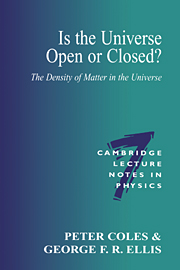4 - Element abundances
Published online by Cambridge University Press: 25 January 2010
Summary
One of the great successes of the hot-big-bang model is the agreement between the observed abundances of light elements and the predictions of nucleosynthesis calculations in the primordial fireball. However, this agreement can only be made quantitative for certain values of physical parameters, particularly the number of light neutrino types, neutron half-life and cosmological entropyper-baryon. Since the temperature of the cosmic microwave background radiation is now so strongly constrained, the latter dependence translates fairly directly into a dependence of the relative abundances of light nuclei upon the contribution of baryonic material to Ω0. It is this constraint, the way it arises and its implications that we shall discuss in this chapter. For more extensive discussions of both theoretical and observational aspects of this subject, see the technical review articles of Boesgaard & Steigman (1985), Bernstein et al. (1988), Walker et al. (1991) and Smith et al. (1993).
Theory of nucleosynthesis
Prelude
We begin a brief description of the standard theory of cosmological nucleosynthesis in the framework of the big-bang model with some definitions and orders of magnitude. The abundance by mass of a certain type of nucleus is the ratio of the mass contained in such nuclei to the total mass of baryonic matter contained in a suitably large volume. As we shall explain, the abundance of 4He, usually indicated with the symbol Y, has a value Y ≃ 0.25, or about 6% of all nuclei, as determined by various observations (of diverse phenomena such as stellar spectra, cosmic rays, globular clusters and solar prominences).
- Type
- Chapter
- Information
- Is the Universe Open or Closed?The Density of Matter in the Universe, pp. 69 - 88Publisher: Cambridge University PressPrint publication year: 1997

